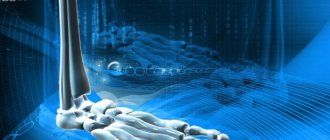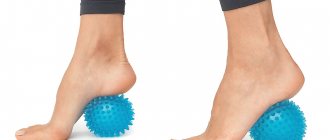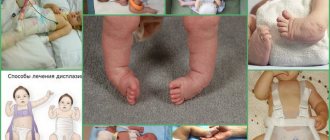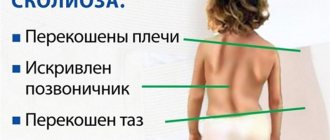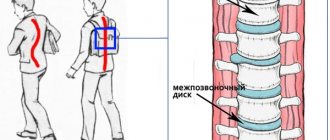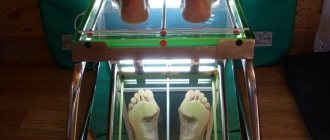From this article you will learn: how to determine flat feet in a child, why flat feet are dangerous for children, what are the signs of flat feet. At the end of the article, a list of measures for the prevention of childhood flat feet is presented.
Very often we begin to fuss and do something already at the moment when the disease completely takes hold of us and either develops into chronic or brings unbearable pain. Very often we wait until the last minute, hoping that the disease will go away on its own. However, there are a number of diseases that not only do not go away on their own, but also aggravate the condition of your body, bringing many problems and unpleasant symptoms. Flat feet just belong to this type of disease. If you periodically experience back pain while walking, and you are also bothered by discomfort in your legs after a walk, then you should seriously think about your health. It is unlikely that these symptoms will force you to see a doctor, and you will probably think that it is all about back problems. However, few of us know that back pain is just a consequence, and the cause of the ailment lurks in a completely different place, namely in your feet. Since ancient times, people have known that there are a large number of points on human feet that are connected to internal organs. This fact allows us to draw a simple conclusion that if you have problems with your feet, then this threatens a number of concomitant diseases of various types. Doctors recommend carefully monitoring the condition of your feet, because healthy feet ensure not only correct gait and posture, but also the absence of problems with internal organs, as well as healthy muscles and joints. The condition of your entire body depends on your feet. Unhealthy feet lead to wear and tear on the musculoskeletal system and lead to a number of problems.
What is flat feet?
Flat feet are the most common type of musculoskeletal disease. It consists in deformation of the foot, leading to flattening of the latter. As a result, the foot touches the surface with all its points, which is a deviation from the norm. Flat feet can be either congenital or acquired. The cause of this disease can be a person’s work pattern, which forces him to constantly lift weights, as well as weakness of muscles or ligaments, injuries or fractures, diseases of the muscles of the extremities. Flat feet can also be caused by wearing uncomfortable shoes with soles that are too flat, or too narrow or wide. The main factor that influences the appearance of flat feet is heredity. Therefore, if you have a family history of people suffering from flat feet, then you need to take more careful care of your feet and regularly consult an orthopedist. An orthopedist is a doctor who specializes in the prevention, diagnosis, and treatment of diseases of the musculoskeletal system. Already in the first weeks of life, any child undergoes an examination by an orthopedist, and subsequently the parents bring him for an examination every year. The responsibilities of an orthopedist include monitoring the correct development of the child’s limbs, his gait, identifying various abnormalities, such as increased muscle tone and many others. A competent orthopedist should be able to determine whether a child has symptoms of flat feet, and also give competent recommendations to correct the current situation.
X-ray of feet
Diagnosis of flat feet includes a variety of methods for its detection and research, but there are also even more accurate diagnostic methods.
Radiography is considered the most accurate method for determining flat feet. X-rays of both feet are taken in frontal and lateral projections under load, with the patient standing. Next, the orthopedist carefully examines the images, paying special attention to the magnitude of the deformation angles, and based on the data obtained, makes a diagnosis and the degree of flatfoot.
I would like to separately note that the exact determination of the degrees of flat feet, the magnitude of the angles characteristic of each degree of the disease, should be carried out by a purely specialist in his field, an orthopedic doctor, whose consultation you can get in our medical center.
Where to do plantography
You can get a plantography of both feet, get a transcript of the image, as well as doctor’s recommendations regarding the treatment of the disease at our medical Center for Joint Diseases in Shymkent.
Sign up for plantography! Plantography will reveal the degree of flat feet!
APPOINTMENT FOR PLANTOGRAPHY
Flat feet in children
Unfortunately, it is almost impossible to determine whether a child has flat feet in the first years of his life. This opportunity appears only when the child reaches the age of five. Such late dates are explained by the fact that in the early stages of life the shape of the foot in children only begins to form under the influence of the weight of the body. This process is quite lengthy and takes several years. Some parents, trying to independently determine whether their child has flat feet, often come to the wrong conclusions. If you think that you have discovered flat feet in your baby, then do not rush to be upset. We must take into account the fact that at an early age, absolutely all children’s feet seem flat. This is due to the presence on the surface of the foot of a special fatty layer that protects the bone base. However, this does not mean that there are no reasons for concern. Caring parents are obliged to carefully ensure that their child’s feet are formed correctly. If the development of the musculoskeletal system proceeds normally, then by approximately five years of age the baby will already have a correctly shaped foot. Unfortunately, it also happens that various deviations occur in development, which leads to such a problem as flat feet. To prevent this unpleasant phenomenon, experts recommend massage sessions and special exercises aimed at normalizing the development of the foot.
Diagnosis of flat feet.
A diagnosis of flat feet can be made by a specialist in the field of traumatology and orthopedics.
To visually assess the position of bones and joints, an orthopedist uses computer plantoscopy. The possibility of this type of study helps to identify the presence of deviations, the area of overload and the reaction of different areas of the foot to functional tests. A computer plantograph is capable of assessing longitudinal and transverse flatfoot, establishing its degree and shape, detecting deformation of the toes (Hallux Valgus), and assessing the position of the heel bone (valgus or varus deviation of the posterior section).
Flat foot test
You can determine if you or your child has flat feet using a fairly simple test. Take a sheet of paper and stand on it with your bare feet, after lubricating them with something greasy, such as oil. Make sure that your body weight is distributed evenly. If you have absolutely no problems with your feet, then you will see the following picture:
If you receive a print similar to the one shown below, consult a doctor as soon as possible. He will help you understand your problem and make the correct diagnosis.
Please note that in the absence of flat feet, the big toe should form one straight line with the heel. Patients who have flat feet often experience ingrown nails. Also, the presence of flat feet can be indicated by an irregularly shaped foot, as well as slightly curved toes. One of the consequences of flat feet is a protruding bone on the big toe. Flat feet lead to the appearance of various unpleasant symptoms such as “heel spurs” or calluses. This fact is worth taking note of for people with problem feet - perhaps the reason for your numerous calluses lies not in your shoes, but in the irregular shape of your foot. There is only one way to find out - by visiting an orthopedist. Remember that it is never too late to see an orthopedist, even if you are quite old.
We recommend that you familiarize yourself with the following signs of problem feet:
- wear and tear of your shoes on the inside;
- the wide dimensions of your feet do not allow you to fit into your favorite shoes;
- constant feeling of fatigue in the legs when walking;
- an unexpected feeling of discomfort when wearing high-heeled shoes;
- the appearance of swelling, pain or cramps in the legs.
If any of these signs are found in you or, more importantly, in your child, then seek help from a doctor immediately. Remember that flat feet are much easier to eliminate in childhood, when the skeleton has not yet completely ossified.
External signs of flat feet
The insidiousness of this disease lies in the fact that it can go unnoticed for a long time or the symptoms may not be considered evidence of ill health. Everyone's legs hurt from time to time, especially after a long walk or other unusual exercise, but if the pain recurs regularly and does not go away for a long time, you need to be wary. The following symptoms should be the reason for contacting an orthopedist:
- Fatigue of the legs when walking or standing for a long time
- Feeling of heaviness in the legs, swelling at the end of the day and cramps
- Back pain
The feet serve as a support, provide balance and reduce the load on the entire musculoskeletal system, because they spring when walking and thanks to this, the joints of the legs and spine are not subject to excessive stress. The structure of the foot provides shock absorption, since it has two arches - longitudinal and transverse. The longitudinal arch runs along the edge of the foot on the inside. The transverse arch is located under the base of the fingers. The foot springs as long as the height of the arches is sufficient.
We can say that with transverse flatfoot the foot becomes wider, and with longitudinal flatfoot it becomes longer. Although these two types of flat feet can be combined. As the foot becomes deformed, it naturally changes its shape, and the well-known big toe bones, heel spurs, corns and calluses form.
If your shoes wear unevenly, it has become difficult for you to walk in heels, or you notice that your feet seem to have grown, especially in width, do not be lazy to go to an orthopedic doctor. These symptoms do not always mean that you have flat feet. Varicose veins and obliterating endarteritis have similar manifestations, but they cannot be left without treatment.
Read also…. Fractures of the distal humerus
Why is flat feet dangerous?
Many people mistakenly believe that flat feet are not a serious disease and there is nothing terrible about it. Often, flat feet are considered just as an unpleasant cosmetic defect and are not even perceived as a disease. Most people are absolutely indifferent not only to problems with their own feet, but also to the presence of flat feet in their children. This attitude is unacceptable and unforgivable. Very often, parents, not realizing the seriousness of such a disease as flat feet, are not at all eager to show their child to a doctor. It seems to them that this disease does not have any negative impact on the health of their child and does not in any way affect his well-being or behavior, so they believe that there is no need to rush. In such a situation, it is necessary that every parent is firmly aware of the seriousness and danger of the consequences that flat feet can lead to in the absence of timely measures to treat it. Flat feet can lead to complications and deformation of the bones of the foot, as well as numerous diseases associated with the musculoskeletal system. Behind the apparent harmlessness of flat feet, there are hidden ailments such as radiculitis, vertebral hernia, arthritis and osteochondrosis. All problems begin with a rather banal fatigue when walking, which occurs unusually quickly and often. We do not attach much importance to these symptoms, believing that they can simply be tolerated, and they do not carry any serious consequences. However, when we understand what is wrong and rush to correct the situation, it is often too late. Flat feet can also cause curvature of the spine, as well as constant pain in the legs and back, which interferes with normal life. Further development of flat feet threatens not only clubfoot, but even lameness. The presence of energy points located on the feet allows some experts to claim that the causes of many diseases are not nerves, as many people think, but rather flat feet. This makes many doctors insist that flat feet need to be treated. Despite the length and complexity of the process of treating flat feet, you can get rid of it if you do it as soon as possible. Remember that flat feet will not go away on its own, and the more you neglect the disease, the more expensive and difficult the treatment will be. Physiotherapeutic methods, special physical education and massage are used to treat flat feet. It will also be effective to use special techniques aimed at strengthening the muscles of the feet and improving blood circulation in them. If diseases resulting from flat feet are detected, the orthopedist may prescribe special massage procedures or gymnastics, with the help of which you can restore your health. Also, people suffering from flat feet are recommended to wear special shoes made from natural materials and ideal in size. It should have a small heel and a fairly flexible sole. Also, a specialist should select individual insoles and arch supports for the patient. Such insoles are a real remedy and should only be prescribed by your doctor.
Treatment methods for flat feet
At the Alan Clinic Center for Neurology and Orthopedics, a number of modern, mild in their effects, but very effective methods are used to treat flat feet:
- Manual therapy
- Osteopathy is treatment done by a doctor, with a gentle effect on the musculoskeletal system, nervous and vascular systems, and internal organs.
- Medical massage
- Acupuncture - exposure to biologically active points with microneedles.
- Laser reflexology is a painless effect on reflexogenic zones and points.
- Tsubotherapy is a gentle effect on the reflex points of the body.
- Pharmacopuncture is the introduction of medicinal drugs of natural origin to the source of the problem.
- Plasma therapy is the introduction of the patient’s own purified blood into the site of the disease.
- Isometric kinesiotherapy - individual gymnastic techniques/exercises, according to indications, with elements of joint massage.
- Kinesiotherapy using the Exart installation
- Kinesio taping
- Ozone therapy is treatment with active oxygen.
- Physiotherapy
- Physiotherapy with enzyme preparations
- Shock wave therapy
- Medical droppers
- Hirudotherapy - treatment with leeches.
- Botulinum therapy is treatment with botulinum toxin.
- Intra-articular injection of synovial fluid endoprostheses
- Intra-articular blockades
Prevention of flat feet in children
However, instead of wasting money, time, and most importantly nerves on getting rid of flat feet, a much better solution would be to eliminate the possibility of this disease in advance. Continuous implementation of preventive measures will help you with this. First, you need to make it a rule to undergo an annual examination by an orthopedist. The easiest way to prevent it is to undergo regular examination by an orthopedist. Another important step to preventing flat feet is choosing comfortable children's orthopedic shoes. Particular attention should be paid to the soles of shoes. It should be quite soft and flexible, and also be made of natural material. The child should feel as comfortable as possible in the shoes: the toes should be positioned freely, and the heel should be securely fixed with a hard heel. Avoid wearing heavily worn and worn shoes, as they have a negative impact on your feet. When you are outside the city in nature, do not be too lazy to walk barefoot more often, choosing mainly uneven surfaces such as sand, stones or small pebbles. To prevent flat feet, you can use special insoles. They reduce the load on the legs, and also help relieve pain when walking and contribute to the formation of the correct foot geometry.
A set of exercises to prevent flat feet
There are many special exercises designed to prevent flat feet. All of them are aimed at strengthening the muscles and ligaments located on the feet. After all, flat feet arise from the fact that the muscles of the foot become not strong enough to support it in an elevated position. Here is a set of simple but extremely useful exercises that will help you avoid flat feet if you perform them regularly.
The complex begins with a position sitting on a chair. In this position, perform the following elements:
- flexion and extension of toes;
- alternately lifting heels and toes off the floor;
- circular movements of the feet;
- pulling socks towards and away from you;
- the maximum possible spread of the heels to the sides without lifting the toes off the floor.
How does flat feet affect health?
Flat feet are one of the most common orthopedic problems. According to statistics, more than half of the world's population suffers from this pathology. With this disease, the arches of the feet become flatter, causing the load on the entire body to be distributed incorrectly. Violation of the biomechanics of the foot changes the natural position of the knee and hip joints, which negatively affects their functioning. Increased stress that they cannot cope with can lead to arthrosis, meniscus damage and joint instability.
Photo: unsplash.com/@lucaxxfreire
Changes in the feet and joints make it difficult to maintain correct posture. Therefore, the spine usually bends to compensate for the load. Thus, flat feet can cause the development of scoliosis, osteochondrosis, intervertebral hernias and other orthopedic diseases.
Based on the type of foot deformation, there are three types of flat feet:
- longitudinal (“the medial longitudinal arch sags—the depression between the heel and metatarsus smooths out or completely disappears);
- transverse (the transverse arch—the depression under the fingers—is smoothed out or completely disappears);
- combined (flat feet are present both transversely and longitudinally, but, as a rule, one of the types predominates).
One type of foot deformity, which is considered a complication of the disease, is planovalgus feet. In this condition, the feet “fall” inward - this is best seen when viewed from behind: when walking, the heel assumes a position inclined to the ground. Patients with planovalgus feet also experience severe and uneven shoe wear: the heel wears away only on the inside.
Flat feet: types of causes, diagnosis, consequences
Flat feet is a disease of the musculoskeletal system in which the arches of the feet are reduced. With this disease, the biomechanics of walking are disrupted and a number of complaints arise from the ankle, knee, hip joints and even the spine.
More than 50% of the world's population suffers from flat feet, and according to some data, up to 70-80%. It occurs 4 times more often in women than in men. By the age of 11, when the foot almost completes its formation, flat feet are diagnosed to one degree or another in half of adolescents.
Each foot consists of 26 bones, 109 ligaments, 33 joints and 19 muscles. All these structures together form the most “perfect shock absorber” created by nature. When walking, our feet protect the overlying sections from mechanical shock, dampening the resulting shock load. When the shock absorber breaks down, the large joints of the legs try to perform this function, but they are poorly adapted to perform this function. Therefore, a violation of the arched structure of the foot leads to its flattening, disruption of the spring function, the inevitable occurrence of complaints, and all this lies behind the diagnosis - flat feet.
Among the reasons influencing the appearance of flat feet can be identified: Internal
The reasons are related to the congenital features of the development of the human musculoskeletal system. People with congenital connective tissue weakness (congenital connective tissue dysplasia) are prone to flat feet. The structure of the ligaments connecting the bones of the foot includes connective tissue. If there is dysplasia, the connective tissue is more elastic. It stretches and cannot withstand loads. This also includes all causes of muscle weakness.
External
The reasons that affect the condition of the muscles and ligaments of the foot and, accordingly, the development of flat feet are:
- Staying on your feet for a long time, professions associated with long walking or the need to stay on your feet for a long time.
- Heavy physical activity.
- Excess body weight, weight gain during pregnancy.
- Shoes are one of the most common reasons that most people do not give due importance. The heel in the shoe must be present, but not more than 4 cm. For this reason, women suffer from flat feet more often, as they prefer to wear high-heeled shoes, which greatly changes the normal functioning of the foot and leads to overload of the forefoot. The higher the heel, the more the center of gravity moves forward. The result is transverse flat feet!
- Another common cause is a foot injury with a fracture of the foot bones. Or, simply put, after an injury a person is forced to walk for a long time with support on one leg. One foot is forced to bear a significant load. During this time, compensatory possibilities are exhausted. Even some time after the injury, when the person has returned to normal life, pain occurs in the previously overloaded foot.
Manifestations
flat feet are very diverse. Complaints can arise both against the background of flat feet itself, and can be hidden behind other symptoms. Flat feet can aggravate the course of many diseases. Even increased pain in the lumbar spine may be associated with foot pathology.
- The first thing people pay attention to is fatigue and even pain in the legs and top of the foot after prolonged exercise. These painful sensations usually go away with rest.
- People then notice changes in foot size. It becomes longer and wider. Now shoes are bought a size larger.
- Shoes do not wear down evenly, mainly from the inside.
- Swelling of the distal parts of the lower extremities (feet and ankle areas) appears.
- Pain in the heel in the morning, when getting out of bed.
- Over time, hallux valgus deformity of the 1st toe (hallux valgus) appears and begins to progress. This condition is also known as bunion.
Diagnostics
flat feet begins with examination and collection of the patient’s medical history. During the examination, attention is paid to the color of the skin, the presence of calluses, visual deformations, the presence of the arch of the foot under load and without, as well as the nature, wear and quality of the shoes.
In addition, methods such as:
- Plantography
– obtaining a foot print on a plane. Plantography provides approximate data on the condition of the arches of the feet. If flat feet are suspected, the examination should not stop only at this diagnostic method.
- Podometry
– measurement of external parameters of the feet.
- Podography
is a method that allows you to study the biomechanics of walking and the temporal parameters of movement. For this purpose, special diagnostic complexes are used. Using the method, gait is analyzed, the phases of heel roll are studied, and the gait rhythmicity coefficient is calculated. - To assess the condition of the muscles of the legs and feet, you can use electromyography
. The condition of the muscles of the foot and lower leg directly indicates the severity of flat feet. - X-ray examination of the foot
. Today, this diagnostic procedure is given almost the leading role in the diagnosis of foot pathology. X-ray examination allows you to assess the nature of disorders in the foot, determine the degree of flatfoot, monitor the progression of the disease over time and evaluate the results of treatment. The examination is performed in the position of static load, anteroposterior and lateral projection.
However, given the radiation exposure, there is not always a need to perform x-rays of the feet, especially in children. Today, there are excellent software and hardware systems that allow you to evaluate all the same parameters as in an X-ray examination of the foot. X-rays of the feet are absolutely necessary for people preparing for surgical treatment.
Treatment of flat feet
extremely difficult task!!! The key to success in achieving a positive result is:
- Timely start of treatment. The more severe the flatfoot, the more pronounced the anatomical changes in the feet, which can no longer be corrected conservatively.
- Active participation of the patient himself. A person is required to comply with certain rules and regime, which no one will follow instead of him. If there is no understanding of this, there will be no effect from the treatment.
- A complex approach. It is necessary to use or combine several techniques simultaneously.
- Repeat all these recommendations and prescribed procedures regularly
!
It is important to understand that treatment is long-term, years and decades. Towards conservative
methods include:
- Fighting pain. For these purposes, the entire arsenal of physiotherapeutic methods is used.
- Strengthening the muscles and ligaments of the foot. Regular exercise trains the calf muscles and small muscles of the foot, which are involved in maintaining the correct shape of the foot.
- Selection of comfortable shoes. Shoes should not have high heels and very narrow toes. There should also be a flexible sole.
- Orthopedic insoles.
The ineffectiveness of conservative treatment methods and severe symptoms and deformation of the feet are indications for surgical
treatment.
To date, more than 500 methods of foot surgery have been proposed. Fundamentally, they can be divided into: operations on soft tissues, operations on bones and combined operations. Carefully planned and performed surgery significantly reduces the risk of recurrence, but the failure rate of surgeries remains high throughout the world. Author: Serdyuchenko Sergey Nikolaevich Orthopedic traumatologist of the highest category
